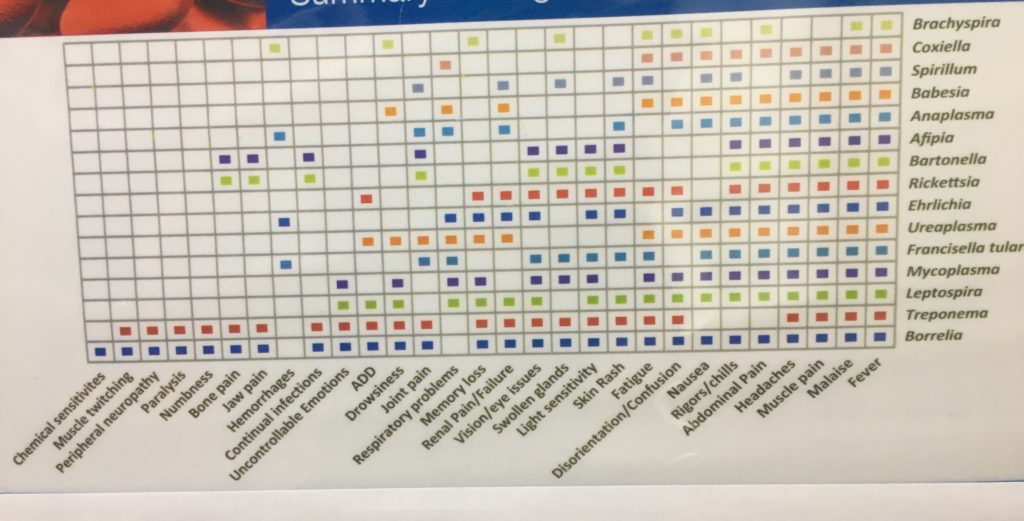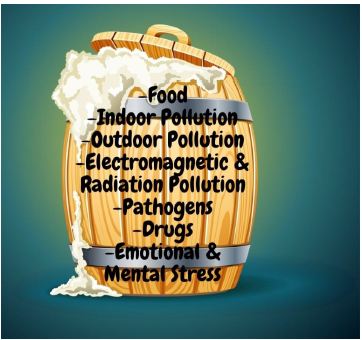
Lyme Disease is complex. There are a myriad of symptoms that come from various co-infections. On top of that mercury toxicity and mold toxicity complicate the picture. The picture above demonstrates the various co-infections and related symptoms.
What is Lyme?
It is an infection most commonly contracted from a tick bite. It may initially cause flu-like symptoms that never really go away with a possible bullseye rash around the site of the tick. The main infection in Lyme is the bacteria Borrelia, but there are also 4 main co-infections, and other lesser known coinfections that can be present.
Lyme can occur in an acute state (flu-like symptoms after a tick bite), or a chronic state with a myriad of symptoms affecting many systems in the body. (See the list of symptoms at the end of this post). Lyme is considered the “Great imitator” because its symptoms mimic that of many disease processes.
How is it transmitted?
- It is spread primarily through the bite of a deer tick; some researchers believe that other ticks and some biting insects such as mosquitoes, fleas, deerflies and lice can be secondary vectors
- Babies may be born infected if the mother is infected. Some research has shown it can be transmitted through breast milk.
- A contaminated blood transfusion may transmit the disease to the recipient
- Some medical researchers also believe that Lyme or other tic-borne diseases may be sexually transmitted
Inadequate testing:
Lyme can be considered a stealth infection – these infections attack the immune system but it is unable to sound the alarm – and that is how traditional blood work detects infections. Clinical assessment of symptoms and a detailed health history can usually point to what is happening, but the reliance on lab tests that are inadequate, makes it difficult for conventional practitioners to pinpoint the problem.
Other factors in chronic conditions
It is rare that only one factor is impacting a person’s overall health, especially in the case of chronic conditions. The following are very common factors that also impact health, whether or not you have Lyme.
– mold toxicity (black mold)
– parasite infection
– heavy metal toxicity
– Epstein Barr Virus
-Electromagnetic radiation stress
-Unresolved emotional issues
-Trauma and PTSD
-Food sensitivities
-Gut/GI imbalance
-Candidiasis
-Dental disturbance
-Hormonal imbalance
-Adrenal fatigue

It is a complex condition that can overwhelm the body’s healing response creating an overflow of symptoms. There are various methods of healing from this condition at the root causes of disturbance.
Below is a fairly comprehensive list of symptoms of each co-infection:
Symptoms of Borrelia
-Fever
-Malaise
-Muscle pain
-Headaches
-Abdominal Pain
-Rigors/chills
-Nausea
-Disorientation/Confusion
-Fatigue
-Skin Rash
-Light sensitivity
-Swollen glands
-Vision/eye issues
-Renal Pain/Failure
-Memory loss
-Joint pain
-Drowsiness
-ADD
-Uncontrollable Emotions
-Continual infections
-Jaw pain
-Bone pain
-Numbness
-Paralysis
-Peripheral neuropathy
-Muscle twitching
-Chemical sensitivities
Symptoms of Mycoplasma (coinfection)
-inflammation especially in gut, lung, chest and bladder
-pain
-migraine headaches
-cough and sore throat
-rheumatoid arthritis which can result in severe joint swelling and deformity
-crawling feeling under the skin
-sensitive to touch
-unusual rashes
Symptoms of Babesia (coinfection)
-cognitive problems, such as trouble focusing and concentrating
-mood fluctuation
-depression and anxiety
-fear
-POTS – postural orthostatic tachycardia syndrome
-racing heart at rest and/or an irregular heartbeat and pounding heart at night
-shortness of breath
-sweats and chills
-insomnia
-blurred vision
-bowel-motility issues and bladder difficulties, sometimes diarrhea
-wrist, hands, ankle and feet pain and numbness
Symptoms of Bartonella (coinfection)
-joint pain and generalized pain in the body
-headache and ice pick-like pain
-irritable and anxious
-depression
-gastritis, loss of appetite and/or heartburn
-sore throat
-frequent urination
-interstitial cystitis, or other chronic inflammatory conditions of the urinary system
-fever
-eye issues like conjunctivitis or inflammation of the outermost layer of the eye
-skin related problems including acne
-elevated liver enzymes
-cognitive problems, such as trouble focusing and concentrating
Symptoms of Rickettsia (coinfection)
-skin and scalp rashes (especially on the palms and soles)
-congested circulation
-blotchy and mottled skin
-edema
-headaches
-forgetfulness
-difficulty focusing, blurriness
-numbness, tingling, and joint pain
Other Co-infections
Brachyspira
Coxiella
Spirillum
Anaplasma
Afipia
Ehrlichia
Ureaplasma
Francisella Tularensis
Leptospira
Treponema:
Powassan Virus (brain inflammation)
